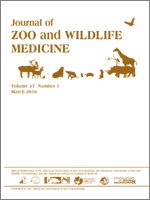In order to improve understanding of parasitism in South American pinnipeds, respiratory and gastrointestinal samples were collected from 12 Arctocephalus australis (South American fur seal), one Arctocephalus gazella (Antarctic fur seal), and one Otaria flavescens (South American sea lion). Ova and larvae were microscopically identified from fecal samples and respiratory secretions collected from live A. australis undergoing rehabilitation at Centro de Recuperação de Animais Marinhos (CRAM-FURG) in Rio Grande, Rio Grande do Sul, Brazil during June–July 2012. Adult parasites were collected from the lungs and gastrointestinal tracts of animals that died while undergoing treatment or were found dead along the southern Brazil coast. Parasites were identified by polymerase chain reaction and DNA sequencing, microscopic examination, comparison with keys, and histologic examination of tissues. Lung parasites of the Parafilaroides genus (Metastrongyloidea, Filaroididae) were identified at necropsy in both A. australis and A. gazella and gastrointestinal parasites were found in all three species of pinniped studied. Gastrointestinal parasites identified in A. australis included the nematodes Contracaecum sp. and Pseudoterranova cattani, the cestodes Adenocephalus pacificus (previously Diphyllobothrium pacificum), one from the Tetrabothridae family and one undetermined, and the acanthocephalans Corynosoma sp. and Bolbosoma sp.; from A. gazella the nematode Contracaecum sp. and the acanthocephalan Corynosoma sp.; and from O. flavescens the acanthocephalan Corynosoma sp. Ova from fecal samples from A. australis represent ascarid nematodes, Parafilaroides sp., Adenocephalus pacificus, acanthocephalans, and an egg determined either to be a trematode or pseuophyllidean cestode. With limited information surrounding parasitism, these findings are an important contribution to knowledge of the health of Southern Hemisphere pinnipeds.
How to translate text using browser tools
1 March 2016
IDENTIFICATION OF RESPIRATORY AND GASTROINTESTINAL PARASITES OF THREE SPECIES OF PINNIPEDS (ARCTOCEPHALUS AUSTRALIS, ARCTOCEPHALUS GAZELLA, AND OTARIA FLAVESCENS) IN SOUTHERN BRAZIL
Kristy Jacobus,
Juliana Marigo,
Silvia Bainy Gastal,
Sueli Akemi Taniwaki,
Valeria Ruoppolo,
José Luiz Catão-Dias,
Florina Tseng
ACCESS THE FULL ARTICLE
Antarctic fur seal (Arctocephalus gazella)
Parafilaroides
parasites
South American fur seal (Arctocephalus australis)
South American sea lion (Otaria flavescens)





